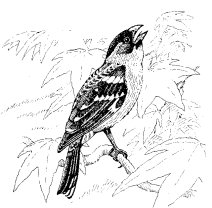
BLACK-HEADED GROSBEAK
| Online Library: | Title | Author | California | Geology | History | Indians | Muir | Mountaineering | Nature | Management |
Yosemite > Library > Birds of Yosemite > Finches, Sparrows, etc. >
Next: Infrequent Species • Contents • Previous: Tanagers

BLACK-HEADED GROSBEAK |
Frequents chiefly oak woodland, willow-cottonwood association, and open coniferous forests, often near a stream. Inhabits the Lower Sonoran to the Transition life zone in summer. Common S. V. in the Yosemite region. Often seen about habitations in Yosemite Valley.
LAZULI BUNTING (Passerina amoena): 5-5 1/2 in. Head, neck, lower back, and rump bright blue; blue of upper back tinged with brown; black line extends from eye to bill; wings and tail dusky; tail with bluish cast; white wing-bar; breast rusty; remainder of under parts whitish. Female: Upper parts brown; under parts lighter; two buffy wing-bars.
Frequents areas with scattered clumps of brush, weed thickets, or other low vegetation on hillsides, often near streams. S. V. in the Lower Sonoran to the Transition life zone. On both slopes of the Sierra in the Yosemite region. On the west slope ranges as high as Yosemite Valley.
PURPLE FINCH (Carpodacus purpureus): 5 1/4-6 in. Rosy red on head, nape, throat, upper belly, and rump; lower belly whitish with vague dark streaking; brown wings and tail; tail quite deeply forked. Female: Grayish-brown, streaked; brown patch back of eye bordered above and below by broad pale stripes. Song resembles that of the house finch, lively and rollicking, not abruptly ended after a few notes as in Cassin’s finch.
In summer in the high Upper Sonoran and Transition life zones, frequenting oak woodland and coniferous forest. Favors rather moist, shaded localities. In the Yosemite region in the zones mentioned. Occasional in Yosemite Valley.

EVENING GROSBEAK |
Breeds in coniferous forests of the Transition and Canadian life zones, especially where there are firs. S. V. throughout the Sierra. Occasional in Yosemite Valley.
CASSIN’S FINCH (Carpodacus cassinii): 6-6 1/2 in. Resembles purple finch but distinct crimson crown clearly set off from brown of neck and back and less intense red on breast. Female: Above olive-gray, streaked with sooty or brown; below whitish narrowly streaked with dusky; faint light streak over eye. Song, similar to that of the house finch but abruptly terminated after a few rollicking notes.
Frequents open semiarid coniferous forests, chiefly of the Canadian and Hudsonian life zones but also in the Transition zone and occasionally lower. Sparingly to lowlands in winter. In the Yosemite region R. in forested areas mostly between 6,000 and 10,000 feet. Occasionally observed in Yosemite Valley.

HOUSE FINCH |
Frequents a great variety of situations chiefly in the Lower and Upper Sonoran life zones. Inhabits woodland, forest and chaparral borders, deserts, and cultivated lands. R. at lower elevations in the Yosemite region. C. V. to Yosemite Valley.
PINE GROSBEAK (Pinicola enucleator): 8-9 1/2 in. Head, neck, breast, and rump rose-red; back gray tinged with rosy; wings dark brown with two white wing-bars; large beak; forked tail. Female: Plumage generally gray with hint of red on head and rump. Feeds on berries and needle buds and seeds of coniferous trees.
Frequents chiefly broken coniferous forest often near meadows or a stream in the high Canadian and Hudsonian life zones. Sparse R. in the high Sierra Nevada. In the Yosemite region has been observed at elevations from 8,500 feet up to timberline.
GRAY-CROWNED ROSY FINCH (Leucosticte tephrocotis): 5 1/2-6 1/2 in. Black head-cap, bordered with ash-gray; above grayish-brown; middle area of wings, rump, and belly with varying amounts of rose-red; throat and breast rich brown, darkest on chin; bill and feet black; bill yellow in fall and winter, in male. Female: Resembles male, but colors duller, less rosy; bill lighter. Feeds on insects frozen in the snow or taken on the wing; also eats the seeds of sedges and other plants.
Closely restricted to the Arctic-alpine and high Hudsonian life zones where it frequents alpine turf, snowfields, talus, and cliffs. R. and breeding in the high Sierra, including the Yosemite region.
PINE SISKIN (Spinus pinus): 4 1/2-5 in. Above grayish-brown, streaked with dusky; below lighter, streaked; yellow area in wing and at base of tail; tail short, emarginate. Often seen in flocks, flying in jerky, undulating fashion. Forages for seeds and buds in conifers and other trees and in flower heads about meadows.
Frequents chiefly coniferous trees in the Transition to the Hudsonian life zone. R. in the Yosemite region; seen in Yosemite Valley in summer.
RED CROSSBILL (Loxia curvirostra): 5 1/2-6 1/2 in. Body generally brick red, brightest on head and rump; wings and tail dusky; tips of bill crossed; tail forked. Immature males often with orange, instead of red, and patches of olive and gray. Female: Dull olive-gray with yellowish on under parts and rump; wings and tail dusky. May be seen in small groups high in trees. Beak adapted for prying apart scales of pine and fir cones to obtain seeds.
Frequents coniferous forests of the Transition to the Hudsonian life zone. In the Yosemite region, R. in the Canadian and especially the Hudsonian life zones. Reported as nesting in Tuolumne Meadows.
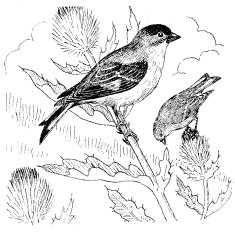
LESSER GOLDFINCH |
Frequents open terrain with scattered trees and bushes. R. in the Lower Sonoran to the Transition life zone. C. V. to Yosemite Valley.
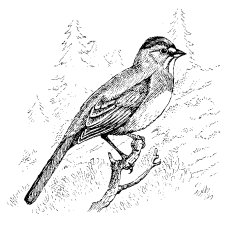
GREEN-TAILED TOWHEE |
Inhabits chiefly chaparral growth of the Transition, Canadian, and Hudsonian life zones. Scattered trees may be present but forests are largely avoided. Thickets of ceanothus, manzanita, and sagebrush are frequented. S. V. in the Yosemite region; often seen in the Mariposa Grove, along the Pohono Trail, and occasionally in Yosemite Valley.
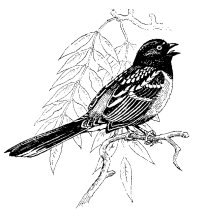
RUFOUS-SIDED TOWHEE |
Frequents chaparral, streamside thickets, and understory brush of open forests. In summer inhabits chiefly the Upper Sonoran and Transition life zones. In Yosemite region has been recorded as high as 7,700 feet, at Glen Aulin. R. in Yosemite Valley and western foothills.
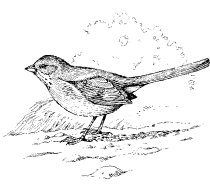
BROWN TOWHEE |
Frequents open brushland, mixed woodland and underbrush, streamside growth, hedges, and shrubbery about homes. Inhabits the Lower and Upper Sonoran life zones, and sparingly enters the Transition zone. R. in the western foothills. C. V. at lower elevations of the park as at El Portal.

VESPER SPARROW |
Frequents open grassland or areas with low annuals and scattered low bushes. In summer inhabits chiefly the Upper Sonoran and Transition life zones but locally enters the Canadian life zone. S. V. on the east side of the Sierra. W. V. to the western part of the Yosemite region. Several records for Yosemite Valley.
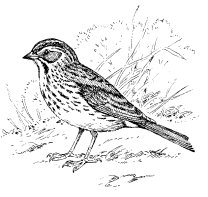
SAVANNAH SPARROW |
Frequents sagebrush, grassland, and marshes. In winter may be seen in cultivated or fallow fields. S. V. in the Lower Sonoran to the Transition life zone. Ranges sporadically into the Yosemite region, largely from the east side, in later summer and fall. Has been recorded at 9,700 feet above Ten Lakes and in Yosemite Valley.
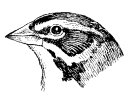
LARK SPARROW |
Frequents open woodland, broken brushland, orchards, or other open terrain with scattered trees or bushes, chiefly in the Lower and Upper Sonoran life zones. R. in the western foothills in the Yosemite region. C. V. to Yosemite Valley.

RUFOUS-CROWNED SPARROW |
Frequents sparse low brush of grassy hillsides in the Upper Sonoran life zone. Especially attracted to sagebrush. R. in the western foothills of the Yosemite region. C. V. to Yosemite Valley.

SAGE SPARROW |
Frequents arid to semiarid lowlands with chaparral or sagebrush and other bushes of desert type. Inhabits chiefly the Upper Sonoran life zone. Frequents the foothills of the Yosemite region on the east and west sides of the Sierra. C. V. to Yosemite Valley.
SLATE-COLORED JUNCO (Junco hyemalis): 5 1/2-6 1/2 in. Head, breast, and back slate-gray, contrasting with white belly; two outer tail feathers completely white, third partly so; no reddish or brown coloration in adult male. Female: Browner above; below pale. Immature: Often with faint brownish or buff on sides.
Frequents a great variety of habitats but often found where there is forest or brush cover of open type. Rare M. and W. V. throughout California except the Colorado Desert. Regular W. V. in the Yosemite region. Has been observed in Yosemite Valley.
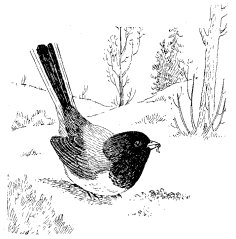
OREGON JUNCO |
Frequents a wide variety of habitats in the mountains but seems to prefer fairly moist woodland or forests with a broken understory. Abundant S. V. in the Yosemite region from the Transition zone to timberline. In winter descends to the foothills. Some remain in Yosemite Valley in winter.

CHIPPING SPARROW |
Frequents open woodland or coniferous forests with little understory vege-tation. Inhabits the Lower Sonoran up through the Hudsonian life zone in summer. S. V. in the Yosemite region, most commonly in the Upper Sonoran and Transition life zones. To be seen in Yosemite Valley.

WHITE-CROWNED SPARROW |
Frequents grassy areas with scattered bushes and trees. In the Sierra seems to favor willow thickets in mountain meadows. In winter in shrubbery, broken tracts of chaparral, etc. In the Sierra, S. V. in the Transition to the Hudsonian life zone. Widespread in the lowlands in winter. In the Yosemite region nests chiefly in the Hudsonian zone but a few nesting records for Yosemite. Common in Tuolumne Meadows area. Fall and winter visitant to Yosemite Valley.

GOLDEN-CROWNED SPARROW |
Frequents broken brushland and tracts of grassy or weedy ground where there is a scattering of bushes and trees. W. V. to western foothills. In the fall in the Yosemite region from the lowlands up through the Canadian life zone. C. V. to Yosemite Valley.

FOX SPARROW |
Frequents chaparral, streamside tangles, and underbrush of woodland and forest. In the Yosemite region S. V. to the Canadian life zone on both slopes of the Sierra. Seen along the rim of Yosemite Valley and in the upper part of Mariposa Grove. Some subspecies M. and W. V. chiefly in the Upper Sonoran zone.
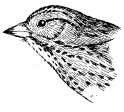
LINCOLN’S SPARROW |
Seeks damp meadows and stream borders in mountains in summer, chiefly in the Canadian life zone but also in adjacent zones. In the Yosemite region in summer in the zones mentioned to 9,000 feet at the head of Lyell Canyon. Nests regularly in meadows of the upper Mariposa Grove. In winter and fall at lower elevations, occasionally including Yosemite Valley.

SONG SPARROW |
Frequents tangles of brush, weeds, and other low growth, usually near water or over damp ground. Often becomes established in shrubbery about dwellings. Breeds over a wide zonal range from the Lower Sonoran to the Hudsonian life zone. R. at lower elevations in the Yosemite region, sparingly including Yosemite Valley and Wawona. W. V. largely below 4,500 feet on the west slope of the Sierra. In the fall stragglers may reach 9,000 feet on the east slope.
Next: Infrequent Species • Contents • Previous: Tanagers
| Online Library: | Title | Author | California | Geology | History | Indians | Muir | Mountaineering | Nature | Management |
http://www.yosemite.ca.us/library/birds_of_yosemite/finches_sparrows.html